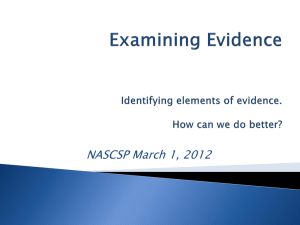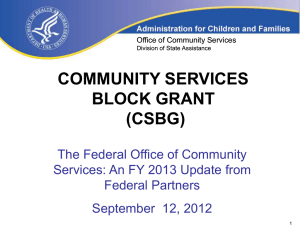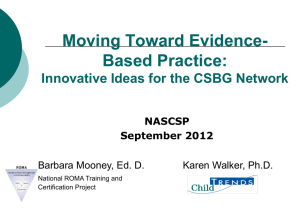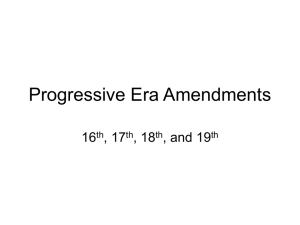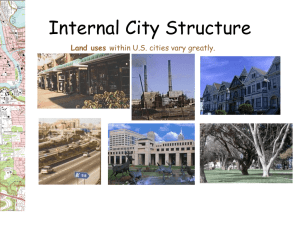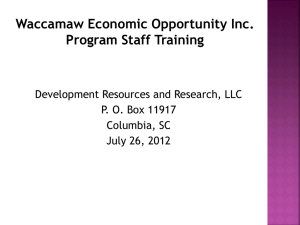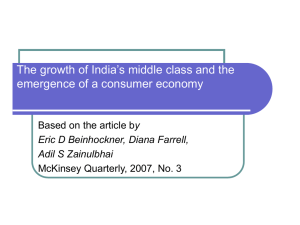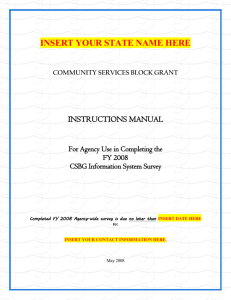CSBG: ROMA Next Generation COE Update
advertisement
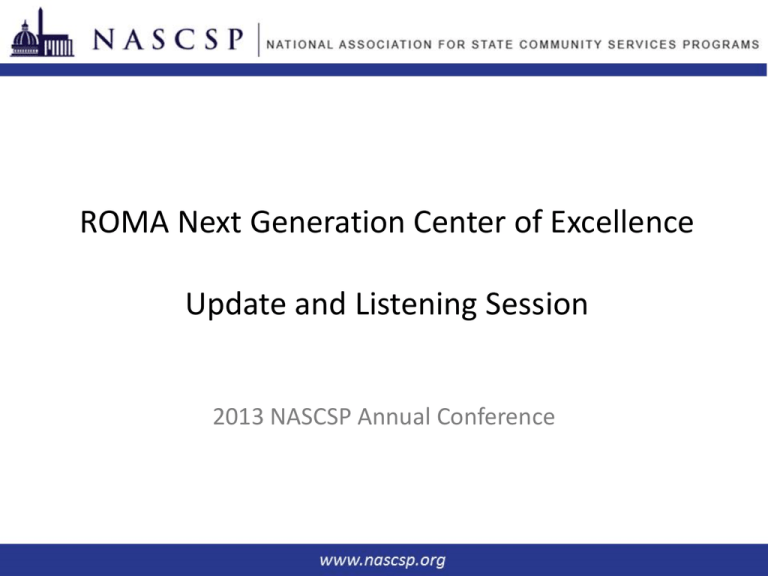
ROMA Next Generation Center of Excellence Update and Listening Session 2013 NASCSP Annual Conference Where We Are 2 • 12 National Webinars • 6 Statewide and National Listening Sessions • 1 National Survey • 3 Iterations of the White Paper • Framing of pilots • Framing of case studies • Engaging other federal programs Where We’re Headed 3 • Release semi-final iteration of the White Paper • Select sites for pilot and case studies • Implement pilots and case studies • Toolkit and training development • Engage NASCSP Monitoring Workgroup But, Before We Get There… 4 We Need STATE specific input • What information do you wish you had on the impact of CSBG? • What will the proposed changes mean for your monitoring and reporting responsibilities? CREATING THE NEXT GENERATION OF ROMA 5 ROMA Next Generation 6 1. Foster a performance culture in the Network 2. Create and implement a Theory of Change process throughout the Network 3. Increase use of client demographic information to contextualize indicators 4. Use a range of indicators to show progress toward family level stability and self-sufficiency ROMA Next Generation, cont. 7 5. Focus on a short list of indicators and outcomes to be used at the federal level 6. Identify which outcomes (from existing and new) give the information needed about core programs at local and state levels (NOTE: Some will be required to be reported to the national data collection system and others will not) 7. Generally reduce the number of items required to be reported while preserving sufficient data to “tell the story.” 8. Make changes to the data collection system to allow for quarterly reporting (GPRA Modernization) and multi year reporting ROMA Next Generation, cont. 8 9. Enhance ability of State CSBG Offices to monitor using ROMA and Organizational Standards 10. Enhance ability of State CSBG Offices to work together with State Community Action Associations, RPICs and national partners to provide training and technical assistance 11. Aim for full implementation of ROMA by all local agencies, State CSBG Offices, and OCS PROPOSED FAMILY LEVEL CHANGES See White Paper, Section Three 9 The Big Questions 10 What’s your impact on the lives of individuals and families? Are people better off as a result of Community Action intervention? What actually happened (what changed) to an individual or family as a result of the services you provided? If Community Action is about moving families to selfsufficiency, how many families have achieved selfsufficiency? If families have not “moved” but have received services to maintain or achieve family stability, how do you measure this accomplishment? What You’ve Told Us 11 • Our work is about stability and self-sufficiency. • Flexibility in reporting should be maintained. • A majority of agencies can provide an unduplicated count of individuals served (according to two surveys). • A majority of agencies can connect family outcomes with the services they receive (both in number and frequency of services and duration of service). • Some of the current NPIs are meaningful and should remain. Some are outputs, should also remain but be separated from the outcomes. • There are too many NPIs. However, we need a good number and a range of indicators to enable us to tell our story. Defining Self-Sufficiency 12 Pathway to Self-Sufficiency STEP THREE STEP TWO STEP ONE The ability to meet family basic needs without public or private assistance, and to have sufficient discretionary income for savings and emergency expenses. The ability to meet family basic needs without public or private assistance. The ability to meet family basic needs. Defining Self-Sufficiency, cont. 13 Basic Needs – housing, utilities/telephone, childcare, food, transportation, health care, clothing and household items, and taxes (minus federal and state tax credits). Public Benefits – programs that limit assistance to those with modest or low incomes/means tested programs such as TANF, SSI, Food Stamps, Rental Assistance, Energy Assistance Sufficient Discretionary Income – ? National ROMA Goals 14 ROMA GOAL ONE: People with low incomes become more self-sufficient ROMA GOAL SIX (REVISED): People with low incomes, especially vulnerable populations, become more stable. Defining Self-Sufficiency, cont. 15 Pathway to Self-Sufficiency – Connecting the Dots STEP THREE The ability to meet family basic needs without public assistance, and to have THRIVING sufficient discretionary income for savings and emergency expenses. GOAL ONE STEP TWO The ability to meet the family’s basic needs without public assistance. GOAL ONE The ability to meet the family’s basic needs. GOAL SIX SAFE STEP ONE STABLE Impact of Proposed NPI Updates 16 • Follow the progress of people who have increased their family income • Identify the number of people who have reduced reliance on public assistance (because their income is sufficient to meet the needs previously met by this assistance) • Identify the number of people who have acquired public benefits to enable them to meet family basic needs • Identify the number of people who have gained skills that support their movement toward stability or self sufficiency • Identify the number of people who have gained assets or resources that support their movement toward stability or self sufficiency Proposed Family NPIs 17 GOAL ONE: People with low incomes become more self-sufficient Outcome 1: People with low incomes increase family income as they move out of poverty. The number of families who move up on the FPG scale Outcome 2: People with low incomes decrease reliance on cash assistance or public benefits. The number of families who move to “Employment Only” or “Employment & Other” from any other income source category. The number of families who report a decrease in reliance on cash assistance or public benefits. Proposed Family NPIs, cont. 18 Outcome 3: People with low incomes achieve improved status or conditions in one of the following: 3.1a 3.1b 3.1c 3.2a 3.2b 3.3a 3.3b 3.4a 3.4b EMPLOYMENT Unemployed and obtained a job Employed and improved employment benefits Employed and maintained a job for at least 90 days TRANSPORTATION Obtained access to reliable transportation Obtained a driver's license HEALTH Obtained health care services for themselves and/or family member Secured health care insurance HOUSING Obtained safe and affordable housing Maintained safe and affordable housing for 90 days Proposed Family NPIs, cont. 19 INCOME MANAGEMENT & ASSET DEVELOPMENT 3.5a Number and percent of participants demonstrating ability to complete and maintain a budget for over 90 days 3.5b Number and percent of participants in tax preparation programs who qualified for any type of Federal or State tax credit and the expected aggregate dollar amount of the credits Number and percent of participants opening an Individual Development Account (IDA) or other savings account Number and percent of participants using savings or tax credits to acquire physical (i.e. housing), developmental (i.e. education) or commercial (i.e. small business) assets Number and percent of participants who obtained court-ordered child support payments and the expected annual aggregated dollar amount of payments 3.5c 3.5d 3.5e Proposed Family NPIs, cont. 20 3.6a 3.6b 3.6c 3.7a 3.7b 3.7c EDUCATION & TRAINING Obtained skills/competencies required for employment Completed ABE/GED and received certificate or diploma Completed post-secondary education program and obtained certificate or diploma FAMILY DEVELOPMENT Parents and other adults learn and exhibit improved parenting skills Parents and other adults learn and exhibit improved family functioning skills Children participate in pre-school activities to develop school readiness skills Proposed Family NPIs, cont. 21 Goal Six: People with low incomes, especially vulnerable populations, become more stable Outcome 4: People with low incomes secure cash assistance or public benefits to stabilize family The number of families who report receipt of new benefits to stabilize the family. The number of families who move from "no income" to another income category. The number and percent of participants who were enrolled in telephone lifeline initiatives. The number and percent of participants who secured energy discounts. Proposed Family NPIs, cont. 22 Outcome 5: People with low incomes facing an emergency or disaster achieve stability due to tangible assistance. ALTERNATE LANGUAGE: People secure assistance to meet needs which are the result of disaster or emergency situation OR People with low income secure assistance to meet recurring need. 5.1a 5.1b 5.1c 5.1d 5.1e Emergency Food Emergency fuel or utility payments funded by LIHEAP or other public and private funding sources Emergency Rent or Mortgage Assistance Emergency Temporary Shelter Other Emergency Proposed Family NPIs, cont. 23 Outcome 6: People with low incomes received services to become or maintain family stability 6.1a Rides Provided 6.1b Information and Referral Services 6.1c Enrolled children in before and after school programs 6.1d Obtained care for child or dependent Outcome 7: Vulnerable populations maintain their independence 7.1a Seniors are able to remain independent 7.1b Individuals with disabilities remain independent Additional Family Level Reporting Questions 24 • Should we make better use of scales and matrices? • If yes, how do we standardize these tools while still allowing for community flexibility to modify benchmark language? • If yes, how might the use of scale and matrices impact reporting? • Do we need separate scales/indicators for youth and senior citizens? 25 Proposed Community Level Changes See White Paper, Section Four The Big Questions 26 What’s your impact on communities? Are communities better off as a result of Community Action intervention? What actually happened (what changed) to the community as a result of the services you provided? Are you a part of “collective action” with partners in your community? What evidence do you have to prove your part in the community level success? What You’ve Told Us 27 • Community Action is about helping maintain or regain community vitality. • We know that family success is inter-related with community success. • Community work takes collaboration and development of different kinds of resources. • Community work is difficult and it often takes multiple years to achieve a single outcome. • We’d like to do more community work. Defining Revitalized Communities 28 Revitalized communities enable everyone to meet their own basic needs. These communities provide opportunities for all individuals to be engaged and to achieve their personal goals. Revitalized communities are healthy, safe and resilient in times of change. Revitalized communities foster a sense of shared purpose and generate a sense of meaningful engagement. National ROMA Goals 29 ROMA GOAL 2: The conditions in which people with low incomes live are improved ROMA GOAL 3: People with low incomes own a stake in their community ROMA GOAL 4: Partnerships among supporters and providers of services to people with low incomes are achieved Defining Revitalized Communities, cont. 30 Pathway to Revitalized Communities – Connecting the Dots STEP FOUR THRIVING STEP THREE SAFE STEP TWO SAFE STEP ONE STABLE Revitalized communities are healthy, safe and resilient in times of change. GOAL TWO Revitalized communities provide opportunities for all individuals to be engaged and to achieve their personal goals. GOAL THREE Revitalized communities foster a sense of shared purpose and generate a sense of meaningful engagement. GOAL FOUR Revitalized communities enable everyone to meet their own basic needs. GOAL TWO What Should be Measured? 31 We discussed proposed changes to community level NPIs which included elements from the following sources: • Promise Neighborhoods • The Opportunity Index • The Partnership for Sustainable Communities • The National Core Indicators Proposed Community NPIs 32 Goal Two: The conditions in which people with low incomes live are improved Outcome 8: Community Action joins with other community stakeholders to improve or create the following assets in neighborhoods with low incomes: 8.1 8.1a DEVELOPMENTAL ASSETS – These are assets that allow residents to attain the skills needed to be successful in all aspects of daily life (e.g., educational institutions, early learning centers, and health resources). Accessible and affordable health care services/facilities created 8.1b Accessible and affordable health care services/facilities saved from reduction or elimination 8.1c Accessible safe and affordable child care or child development placement opportunities created 8.1d Accessible safe and affordable child care or child development placement opportunities saved from reduction or elimination 8.1e Accessible before-school and after-school program placement opportunities created 8.1f Accessible before-school and after-school program placement opportunities saved from reduction or elimination Proposed Community NPIs, cont. 33 8.1g Accessible educational and training placement opportunities created, including vocational, literacy, and life skill training, ABE/GED, and post-secondary education 8.1h Accessible educational and training placement opportunities saved from reduction or elimination, including vocational, literacy, and life skill training, ABE/GED, and postsecondary education 8.2 COMMERCIAL ASSETS – These assets are associated with production, employment, transactions, and sales (e.g., labor force and retail establishments). 8.2a Increase in the availability of commercial services within low-income neighborhoods 8.2b Preservation of commercial services within low-income neighborhoods 8.3 RECREATIONAL ASSETS –These assets create value in a neighborhood beyond work and education (e.g., parks, open space, community gardens, and arts organizations). 8.3a Increase in the availability of community facilities 8.3b Preservation of community facilities 8.3c Increase in neighborhood quality-of-life resources 8.3d Preservation of neighborhood quality-of-life resources Proposed Community NPIs, cont. 34 8.4 PHYSICAL ASSETS - These assets are associated with the built environment and physical infrastructure (e.g., housing, commercial buildings, and roads). 8.4a Safe and affordable housing units created in the community 8.4b Safe and affordable housing units improved in the community through construction, weatherization or rehabilitation achieved by Community Action activity or advocacy 8.4c Accessible new transportation resources, including public or private transportation 8.4d Accessible expanded transportation resources, including public or private transportation 8.4e Accessible transportation resources saved from reduction or elimination, including public or private transportation 8.5 SOCIAL ASSETS - These assets establish well-functioning social interactions (e.g., public safety). 8.5a Increase in the availability of community services to improve public health and safety 8.5b Preservation of community services to improve public health and safety Proposed Community NPIs, cont. 35 Goal Four: Partnerships among supporters and providers of services to people with low incomes are achieved Outcome 9: Community services and resources are accessible and affordable for populations with low incomes or other barrier 9.1a Number of organizations, both public and private, that Community Action actively works with to expand resources and opportunities in order to achieve family and community outcomes 9.1b Number of volunteer hours donated to the agency by the public Proposed Community NPIs, cont. 36 Goal Three: People with low incomes own a stake in their community Outcome 10: People with low incomes are connected to community networks and improve their social capital 10.1 Community empowerment through maximum feasible participation 10.1a Number of volunteer hours donated to the agency by Community Action program participants 10.1b Number of low-income people participating in formal community organizations, government, boards or councils that provide input to decision-making and policy setting through Community Action efforts 10.1c Number of low-income people engaged in non-governance community activities or groups created or supported by Community Action Proposed Community NPIs, cont. • Collective Impact Narrative – Community Intervention Title – Counties Served – Target Population – Shared Measurement System • Gather baseline data • Increase awareness and activity 37 PROPOSED CHANGES FOR REPORTING THE USE OF CSBG DOLLARS See White Paper, Section Five 38 Refining Service Categories 39 FY11 CSBG Expenditures by Service Categories Health 4% Self Sufficiency 17% Other 2% Employment 12% Education 11% Income Management 6% Linkages 14% Housing 8% Nutrition 7% Emergency Services 19% Refining Service Categories 40 We must better define the following categories: • Emergency Services • Self-Sufficiency • Linkages Refining Service Categories, cont. 41 Emergency Services – This would capture the work of Community Action to respond to family emergencies. It would include such things as emergency fuel assistance and rent assistance (Outcome 5). Disaster Relief – This would capture the work of Community Action preparing for and during disasters. It would reflect community level work. As such, it would not be about people with low incomes only. Refining Service Categories, cont. 42 Self-Sufficiency – This would capture the work of Community Action’s direct case management work. It would also capture Community Action’s formal family development/self-sufficiency programs that provide a continuum of assistance (Outcomes 1-3). Linkages – This would capture the work of Community Action around partnership and coalition building (Outcomes 8-9) Refining Service Categories, cont. 43 • Addition of an Organizational Capacity Building category Community Assessment Data and Analysis Strategic Planning Community Engagement Consumer Input Leadership Governance HR Fiscal • High level reporting or is the above level of detail beneficial? • Direct versus capacity building services Refining Service Categories, cont. 44 Reporting of use of CSBG for “Administration” • Administration is not a separate category in Section E, but is included in the service category with which it is related. Should it be separate? • Some agencies “back fill” indirect costs for programs that do not have ability to pay full rate. How is this captured? • Proposed use of CSBG dollars to support improvement in Organizational Standards areas (most of which are administrative) will increase percent of funds spent on admin (see next slide). Is this to be expected? Refining Service Categories, cont. 45 1. Health 2. Employment 3. Education 4. Income Management/Asset Development 5. Housing 6. Emergency Services 7. Disaster Relief 8. Nutrition 9. Linkages 10. Self-Sufficiency 11. Organizational Capacity Building Connecting CSBG Dollars to the NPIs 46 • Linking CSBG dollars to direct services; use the categories other than organizational capacity; connecting CSBG with the outcomes achieved • Some states are already doing this Connecting CSBG Dollars to Other Funding 47 Leveraging: How do we demonstrate the uniqueness that is produced by leveraging CSBG dollars to secure other funding to address our mission? Comparison of Section E categories with reporting of all funding info in Section F Connecting CSBG Dollars to Other Funding, cont. 48 One suggestion is to take the information from Section F and create a graph similar to the one we have of Section E (See example on next slide) Connecting CSBG Dollars to Other Funding, cont. 49 FY11 Section F Allocations FY11 Section E Service Categories Health 4% Other 2% Employment 12% Self Sufficiency 17% Employment 3% Other 20% Education 28% Education 11% Health 4% Income Management 6% Linkages 14% Self Sufficiency 11% Income Management 0% Housing 8% Nutrition 7% Emergency Services 19% Linkages 3% Nutrition 8% Emergency Services 2% Housing 21% Connecting CSBG Dollars to Other Funding, cont. 50 Would your state be able to add a column on Section F and ask reporters to identify how much CSBG funding was used to supplement that resource? (See example on next slide) Connecting CSBG Dollars to Other Funding, cont. 51 DRAFT NATIONAL COMMUNITY ACTION THEORY OF CHANGE (TOC) See White Paper, Section One, Appendix A 52 Current Structural TOC 53 Creating a Programmatic TOC 54 Family SelfSufficiency Assumptions Theories of Poverty Interventions Service Strategies Indicators Intermediate Goals or Milestones Revitalized Communities Long-term Goals DRAFT Programmatic TOC Assumptions 55 The theories of poverty and beliefs Community Action bases is work on... • Poverty Caused by Individual Deficiencies • Poverty Caused by Cultural Belief System Supportive of Subcultures of Poverty • Poverty Caused by Economic, Political and Social Distortions • Poverty Caused by Geographical Disparities • Poverty Caused by Cumulative Cyclical Interdependencies • Poverty Caused by a Lack of Social Capital • Poverty Caused by a Lack of Public Investment in key areas such as education and healthcare • Movement out of poverty is impeded by crisis and a lack of stability • Anti-poverty interventions are most successful when the target audience is included in shaping the intervention • Anti-poverty interventions are most successful when grounded in a local community needs assessment DRAFT Programmatic TOC Interventions 56 The approach Community Action uses to reach its long-term goals... • Community Action designs a range of “light touch” single service interventions and “deep touch” intensive, comprehensive and bundled service interventions to move families toward self-sufficiency and communities toward revitalization. • Community Actions “light touch” and “deep touch” service interventions cover the nine CSBG Service Categories included in the CSBG Statute (employment, education, income management, housing, emergency service, nutrition, linkages, self-sufficiency and health). DRAFT Programmatic TOC Indicators 57 • The indicators to Community Action’s long-term goals are really intermediate goals or major milestones. These would be the NPIs. Next Steps 58 • Engage Committees • Update White Paper • Pilot Reporting Changes • Case Studies of Bundled Services For more information, visit: www.roma1.org Tabitha Beck, Project Lead, tbeck@nascsp.org Barbara Mooney, bmooney@nascsp.org Gretchen Knowlton, gknowlton@nascsp.org Jovita Tolbert, jtolbert@nasc4us.org Mary Virtue, mvirtue@nasc4us.org
